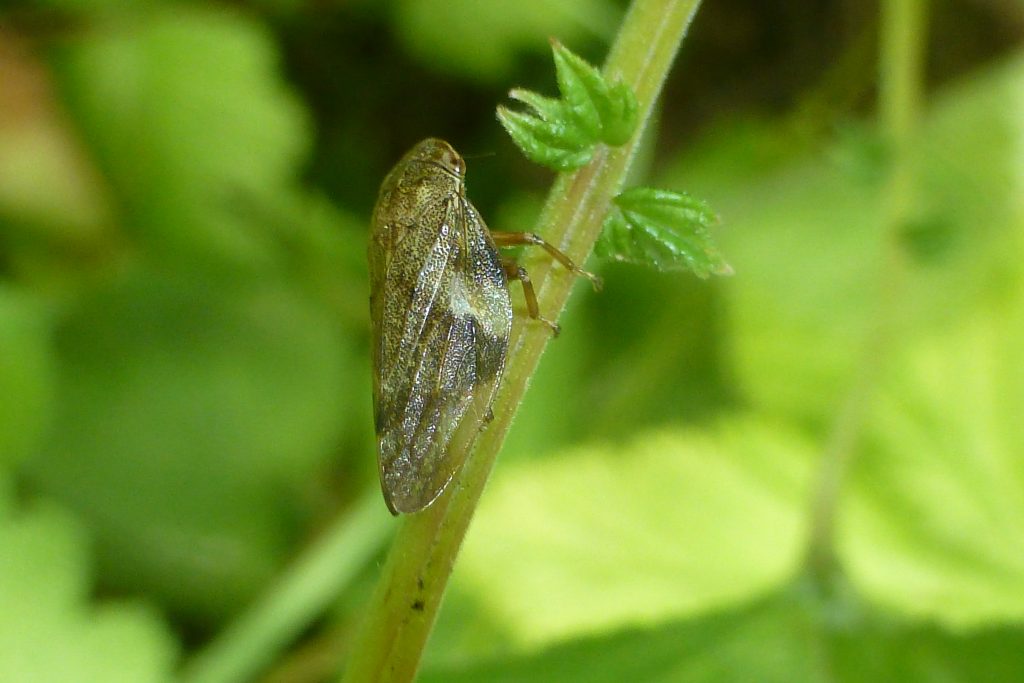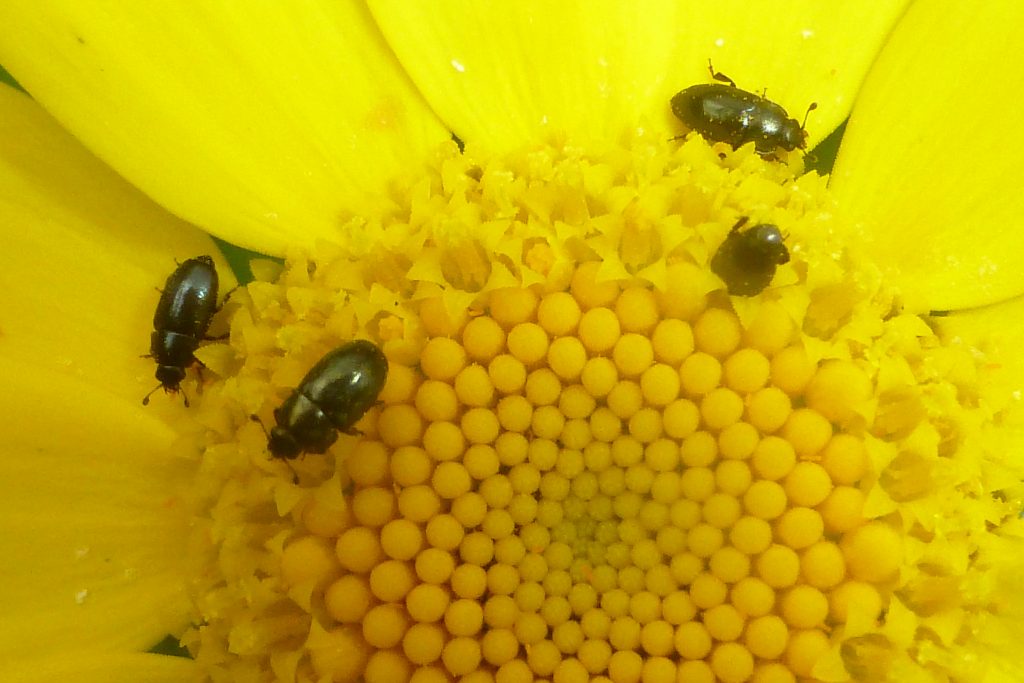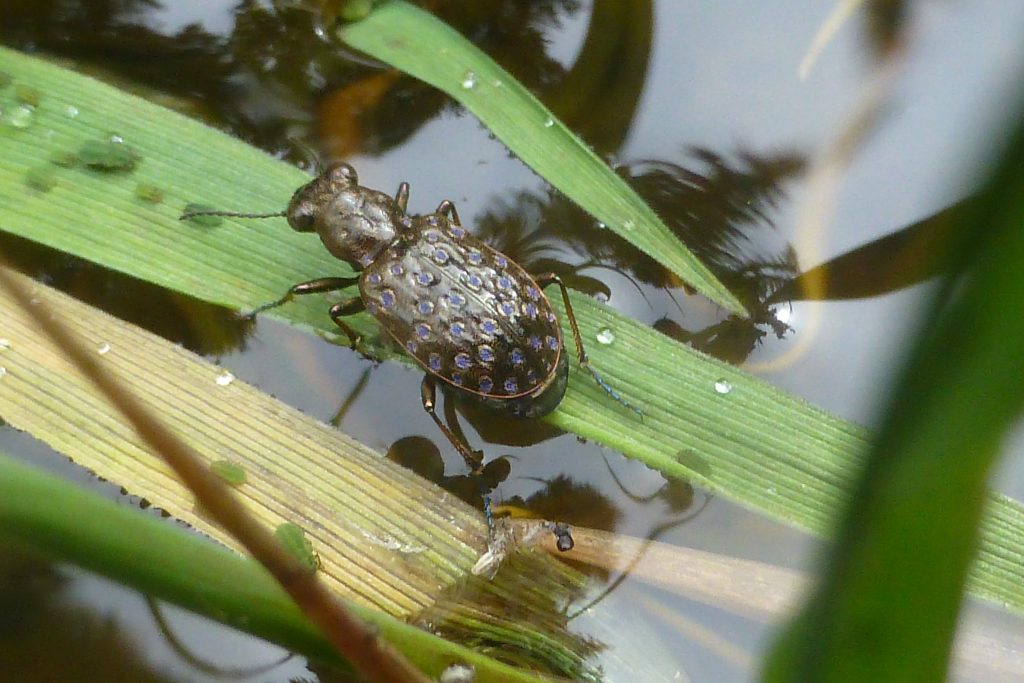
Alder Spittlebug (Aphthophora alni) climbing up a Meadowsweet stem, 27 July 2016. Photo Robert Mill.
July 2016 was mostly rather cloudy and damp although very high temperatures were recorded on a couple of days in the third week of the month. Seven additional species were recorded in the Garden, taking the total list up from 819 to 826. This total may increase as several creatures await identification.
Birds Bird activity always quietens down in the summer months – literally, as just about everything stops singing. This makes finding birds in trees that are in full leaf very difficult. This and the fact that spring migration has ceased and autumn migration, at least of songbirds, has not started, means that fewer species tend to be recorded in urban gardens at the height of summer. Only thirty-one species were recorded at the Botanics in July. Some species such as Chiffchaff, Long-tailed Tit and Song Thrush were only recorded during the first week. There were few notable records although a Buzzard was over the Garden on 5th, and House Martins were present on 18th and 22nd. From the 21st onwards till the end of the month Sparrowhawk activity was very noticeable in the oak lawn and copse areas. The complete list of 31 species recorded during July was: Blackbird, Blackcap, Black-headed Gull, Blue Tit, Bullfinch, Buzzard, Carrion Crow, Chaffinch, Chiffchaff, Coal Tit, Dunnock, Feral Pigeon, Goldfinch, Great Spotted Woodpecker, Great Tit, Greenfinch, Grey Heron, Herring Gull, House Martin, Lesser Black-backed Gull, Long-tailed Tit, Magpie, Mallard, Moorhen, Robin, Song Thrush, Sparrowhawk, Stock Dove, Tree Creeper, Wood Pigeon, Wren.
Insects and other invertebrates: July 2016’s most notable invertebrate record has to be the Common Field Grasshopper seen on 18th and published as a separate Botanics Story (http://stories.rbge.org.uk/archives/21103) – the first record of any member of the Orthoptera for the Garden, and seen on what was probably the second-hottest day of the year. For butterflies in the Botanics, July was as poor as June due to the dearth of warm dry sunny weather to bring them out; once again there were only four records of three species: Meadow Brown (20th), Small White (22nd and 29th) and Green-veined White (21st). A Chamomile Shark caterpillar on cultivated yarrow on 4th was a new Garden record and was written up as a separate Botanics Story http://stories.rbge.org.uk/archives/20930). A Bronze Alder was seen on a birch trunk on 20th. The mines of numerous species of leaf-mining moth began to be evident on trees and bushes throughout the Garden. Two of them, Ectoedemia minimella (25th) and Caloptilia rufipennella (29th) were new Garden records. Wool Carder Bees were recorded throughout the month with numbers steadily increasing especially in the area around the Stachys plants in the Fruit garden near the Botanic Cottage. Late flowering of the Sempervivums in the Rock Garden meant that the bees that frequent that area of the Garden appeared later than usual. Several bumblebee species were seen although there was only one record of Tree Bumblebee (1st). The leafcutter bee Megachile centuncularis was seen on 29th while significant numbers of Field Digger Wasps were present around the new alpine house from 27th. Various leaf-mining sawflies were also recorded as well as three ichneumon wasps, these latter all as yet still unidentified (ichneumons are a particularly diverse group and very hard to identify) – probably all of them will turn out to be new Garden records if named, as they are all unlike species previously seen in the Garden. A Common Darter dragonfly was seen near the Botanic Cottage on 21st. Fewer hoverfly species were recorded than in June, six in all. The picture-winged fly Anomoia purmunda (26th) was a new Garden record. The mines of 21 leaf-mining fly species were found, 14 of them for the first time this year although all had been previously recorded. Four species of shield-bug were seen: Gorse (4th, 21st, 24th and 29th), Forest (4th–7th), Birch and Parent (both on 24th). Four leafhopper species were recorded, with two of them (Kybos cf. betulicola on 18th and Empoasca decipiens on 26th) being new Garden records. Once again four different ladybird species were found: 7-spot (18th & 29th), 2-spot and Cream-spot (both on 26th), and Orange (29th). Common Red Soldier Beetles were first seen on 8th and were particularly numerous from 21st onwards till the month’s end. Pollen Beetles could be found inside the flowers of Asteraceae from 18th onwards, especially among the disc florets of yellow-flowered species although they were also seen in Spear Thistle (Cirsium vulgare) which has mauve flowers. The first harvestman of the autumn (!) season, Leiobunum rotundum, was recorded on 6th and 25th. Several species of gall-forming mite were also recorded. Lastly, a Worm Slug on a birch trunk (20th) was the month’s seventh new Garden record.
Finally, a brief mention must be made of the Benmore BioBlitz from 15th to 17th July, at which no fewer than 707 species of plants, fungi and animals were recorded. Max Coleman has written up the results as a separate Botanics Story (http://stories.rbge.org.uk/archives/21355). Thirty-one bird species were recorded but insect finds were relatively few owing to the wet weather. They included a particularly striking beetle, Elaphrus cupreus, found at the edge of a large permanent puddle – see photo below.


